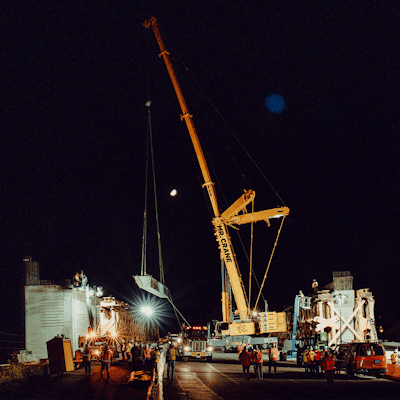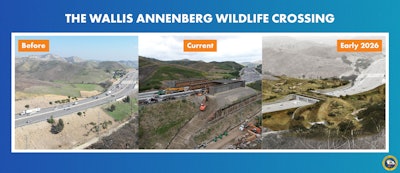
Construction of California’s first “vegetated bridge” – which will be the largest of its kind in the U.S. – is underway over one of the busiest highways in the country.
The bridge over U.S. 101 Ventura Freeway will not only be the largest wildlife crossing of its type in the U.S., but it will provide nearly an acre of wildlife habitat over the busy highway, with another 12 acres of open space on adjacent land.
The Wallis Annenberg Wildlife Crossing at Liberty Canyon in Los Angeles County will be 210 feet long and 174 feet wide.
 A rendering of the future Wallis Annenberg Wildlife Crossing over U.S. 101.Rock Design Associates and National Wildlife Federation
A rendering of the future Wallis Annenberg Wildlife Crossing over U.S. 101.Rock Design Associates and National Wildlife Federation
“Preserving and enhancing this linkage is essential for sustaining wildlife populations,” NWF says. “This crossing will provide a safe and sustainable passage for wildlife across US-101 that reduces wildlife-vehicle collisions and wildlife mortality, allows for the safe movement of animals and the exchange of genetic material for wildlife survival.”
The first girder for the vegetated bridge was placed April 17. In all, 82 reinforced-concrete girders – ranging from 93 to 103 feet long – will cross all 10 lanes of traffic. The girders weigh between 126 and 140 tons each.
 The first of 82 girders is moved into place in April for the Wallis Annenberg Wildlife Crossing.Caltrans
The first of 82 girders is moved into place in April for the Wallis Annenberg Wildlife Crossing.Caltrans
Phase 2 consists of a bridge over Agoura Road; a utility tunnel/bridge structure over a service road; and fill, grade and landscaping between the bridge over US-101 and the bridge over Agoura Road.
Work on Stage 1 began in 2022. Work on Stage 2 is set for 2025. The entire project is expected to be completed by early 2026.
The wildlife crossing is the result of a public-private partnership that includes NWF and Caltrans, with private donations making up $34 million of the funding and the rest coming from the state.
“The Wallis Annenberg Wildlife Crossing is a monumental conservation structure that will help wildlife travel safely across one of the busiest highways in the United States, support local biodiversity, expand refuge for critical pollinator species, and prevent the extinction of the local mountain lion population,” says NWF.
 California Governor's Office
California Governor's Office















